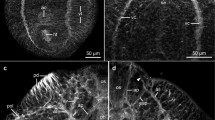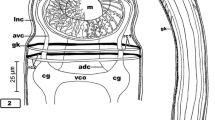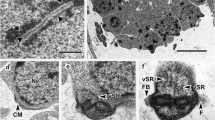Abstract
The localization of catecholamines was documented in the cercaria ofSchistosoma mansoni andS. japonicum by a fluorescent histochmical method using glyoxylic acid (GA). Cell bodies and nerve fibres were spatially visualized in wholemount preparations, and the fluorescent traces were investigated. The nervous system was bilaterally symmetrical, showing a similar formation in both species. A pair of cerebral ganglia with a transverse commussure showed a complex network of fluorophores, and each radiated two sets of anterior and posterior longitudinal nerve cords. A third pair of longitudinal nerve cords was observed in the most dorsal area. A posterior transverse commissure was seen to connect the posterior longitudinal cords, and the posterior terminals of the postero-ventral cords communicated with the tail cords. The glyoxylic acid-induced fluorescence (GAIF) method was demonstrated to be quite suitable for neuroanatomical and neurophysiological investigations of larval forms.
Similar content being viewed by others
References
Bennett J, Bueding E (1971) Localization of biogeneic amines inSchistosoma mansoni. Comp Biochem Physiol A39:859–867
Björklund A, Lindvall O, Svensson LÅ (1972) Mechanisms of fluorophore formation in the histochemical glyoxylic acid method for monoamines. Histochemie 32:113–131
Bruckner DA, Voge M (1974) The nervous system of larvalSchistosoma mansoni as revealed by acetylcholinesterase staining. J Parasitol 60:437–446
Chiba T, Hwang BH, Williams TH (1976) A method for studying glyoxylic acid induced fluorescence and ultrastructure of monoamine neurons. Histochmistry 49:95–106
Chou TCT, Bennett J, Bueding E (1972) Occurrence and concentrations of biogenic amines in trematodes. J Parasitol 58:1098–1102
Fripp PJ (1967) Histochemical localization of esterase activity in schistosomes. Exp Parasitol 21:380–390
Gianutsos G, Bennett JL (1977) The regional distribution of dopamine and norepinephrine inSchistosoma mansoni andFasciola hepatica. Comp Biochem Physiol C58:157–159
König R (1979) Consecutive demonstration of catecholamines and dopamine-β-hydroxylase within the same specimen. Histochemistry 61:301–305
Korkala O, Waris T (1977) The acetylcholinesterase reaction and catecholamine fluorescence in the glomus cells of rat carotid body. Experientia 33:1363–1364
Lewert RM, Hopkins DR (1965) Cholinesterase activity inSchistosoma mansoni cercariae. J Parasitol 51:616
Lindvall O, Björklund A (1974) The glyoxylic acid fluorescence histochemical method: a detailed account of the methodology for the visualization of central catecholamine neurons. Histochemistry 39:97–127
Lindvall O, Björklund A, Svensson LÅ (1974) Fluorophore formation from catecholamines and related compounds in the glyoxylic acid fluorescence histochemical method. Histochemistry 39:197–227
Machado CRS, Machado ABM, Pellegrino J (1972) Catecholamine-containing neurons inSchistosoma mansoni. Z Zellforsch 124:230–237
Mansour TE (1984) Serotonin receptors in parasitic worms. Adv Parasitol 23:1–36
Nakajima Y (1987) Localization of catecholaminergic nerves in larval echinoderms. Zool Sci 4:293–299
Niewiadomska K, Moczoń T (1982) The nervous system ofDiplostomun pseudospathaceum Niewiadomska, (Digenea, Diplostomatidae): I. Nervous system and chaetotaxy in the cercaria. Z Parasitenkd 68:295–304
Pax RA, Siefker C, Bennett JL (1984)Schistosoma mansoni: differences in acetylcholine, dopamine, and serotonin control of circular and longitudinal parasite muscles. Exp Parasitol 58:314–324
Reger JF (1976) Studies on the fine structure of cercarial tail muscle ofSchistosoma sp. (Trematoda). J Ultrastruct Res 57:77–86
Sharpe MJ, Atkinson HJ (1980) Improved visualization of dopaminergic neurons in nematodes using the glyoxylic acid fluorescence method. J Zool 190:273–284
Smyth JD, Halton DW (1983) The physiology of trematodes, 2nd edn. Cambridge University Press, Cambridge London New York New Rochelle Melbourne Sydney
Tiekotter KL (1988) Histofluorescent and ultrastructural identification of aminergic processes in the opisthaptor of the marine monogene,Microcotyle sebastis (Polyopisthocotylea: Microcotylinae). Proc Helminthol Soc Wash 55:229–245
Tomosky TK, Bennett JL, Bueding E (1974) Tryptaminergic and dopaminergic responses ofSchistosoma mansoni. J Pharmacol Exp Ther 190:260–271
Author information
Authors and Affiliations
Rights and permissions
About this article
Cite this article
Orido, Y. Histochemical evidence of the catecholamine-associated nervous system in certain schistosome cercariae. Parasitol Res 76, 146–149 (1989). https://doi.org/10.1007/BF00930837
Accepted:
Issue Date:
DOI: https://doi.org/10.1007/BF00930837




